Sustainable Santa
Swedish American in a Santa Claus costume inspires American children to eat healthy and live green.
-
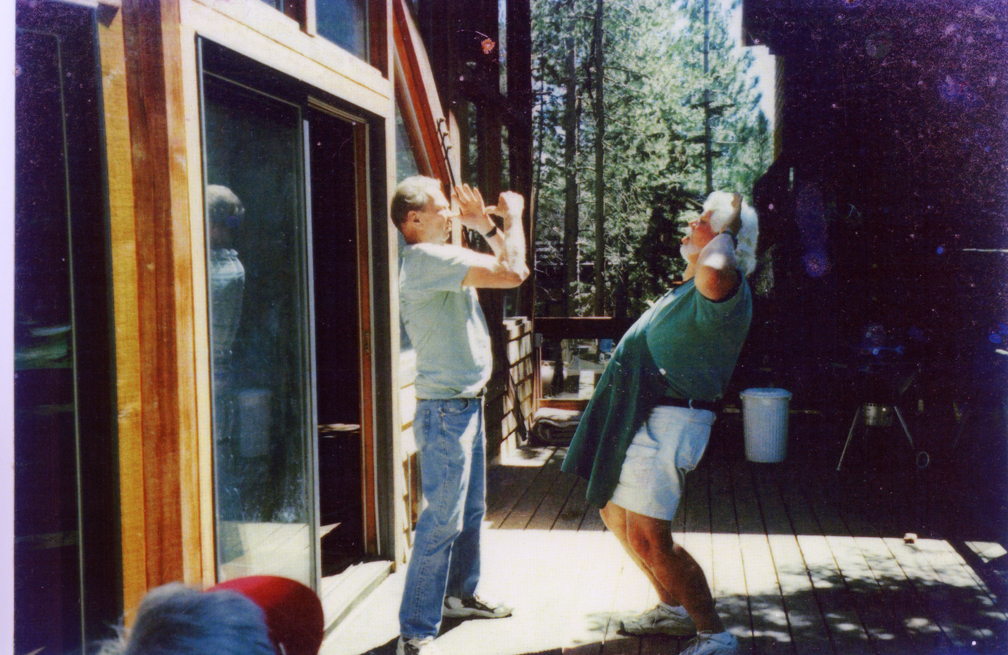 Sustainable Santa and lifelong friend Art Soderblom, at his mountain home in Mammoth Lakes, CA do the Oxendans they learned as children in Solstrålen. This photo was taken before Santa began to practice what he now preaches, having now lost over 70 pounds in order to shed that old American Santa persona. He did it simply by embracing a whole foods, mostly vegetable diet. Former weight 270+; current weight 199 pounds.
Sustainable Santa and lifelong friend Art Soderblom, at his mountain home in Mammoth Lakes, CA do the Oxendans they learned as children in Solstrålen. This photo was taken before Santa began to practice what he now preaches, having now lost over 70 pounds in order to shed that old American Santa persona. He did it simply by embracing a whole foods, mostly vegetable diet. Former weight 270+; current weight 199 pounds. -
-
En svensk man i jultomtedräkt inspirerar amerikanska barn att äta nyttigt och leva miljövänligt.
-
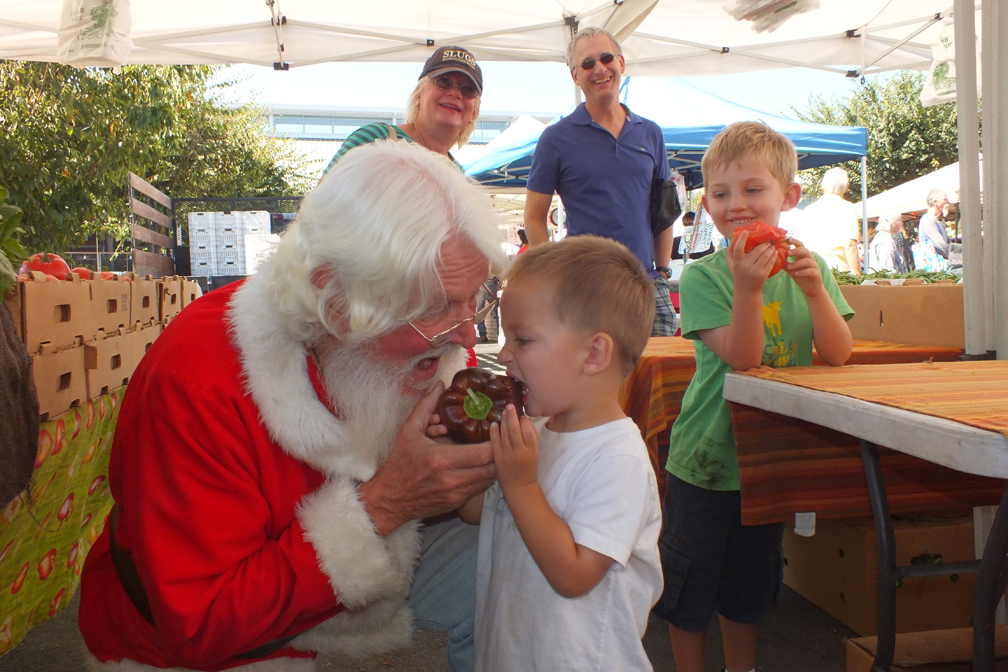 At a farmer’s market, Sustainable Santa introduces young Adam Abrinko to the joy of biting into a freshly picked bell pepper as his father, Dr. Paul Abrinko, Adam’s brother P.J and Mrs. Claus look on.
At a farmer’s market, Sustainable Santa introduces young Adam Abrinko to the joy of biting into a freshly picked bell pepper as his father, Dr. Paul Abrinko, Adam’s brother P.J and Mrs. Claus look on. -
-
Jultomten sows seeds of healthy eating and sustainable living for America’s children.
-
 Local politics are often useful. At the Summer TGIF Friday Night Jazz Concerts in Carlsbad, in southern California, Sustainable Santa takes the stage with city councilmember Lorraine Wood to promote the community’s participation in the city’s new expanded Community Garden program, encouraging the 2,000 in attendance to sign up for a garden plot, thus promoting the goal of eating local and healthy.
Local politics are often useful. At the Summer TGIF Friday Night Jazz Concerts in Carlsbad, in southern California, Sustainable Santa takes the stage with city councilmember Lorraine Wood to promote the community’s participation in the city’s new expanded Community Garden program, encouraging the 2,000 in attendance to sign up for a garden plot, thus promoting the goal of eating local and healthy. -
They are calling him the “Swedish Johnny Appleseed in a Santa suit” as he moves between chapter meetings of the various “Real Bearded Santa” organizations in America. He is spreading the seeds about three “food rules” he encourages his fellow Santa’s to share with the children and their parents this coming Christmas season.
-
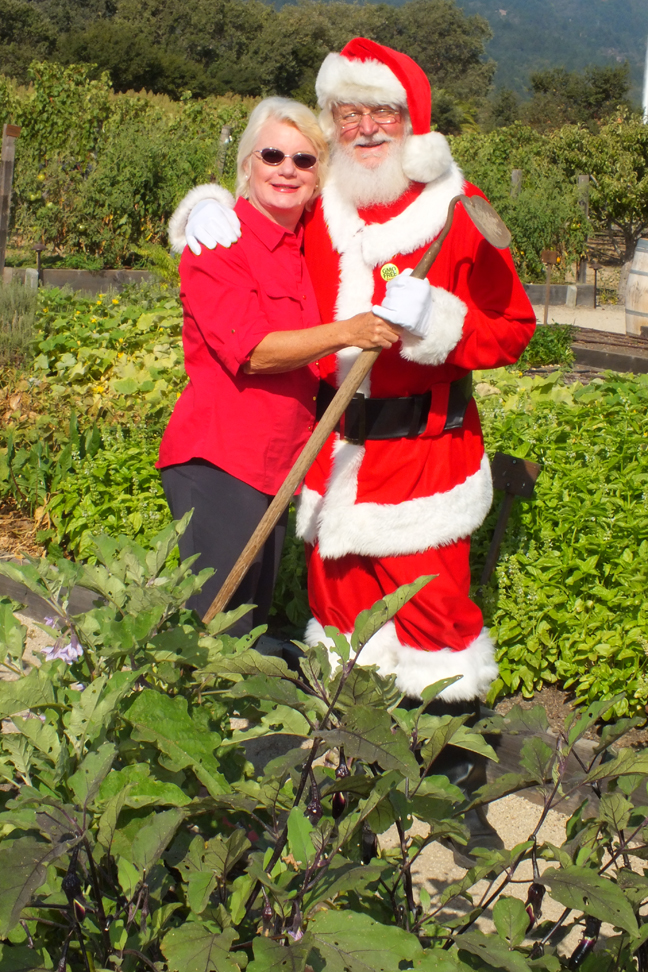 Santa loves to work in Mrs. Claus’ organic, sustainably managed garden. She makes great tomato sauce with the tomatoes, oregano, garlic and basil she grows. But the pasta she uses is made from lentils — not wheat which turns into sugar once inside your body.
Santa loves to work in Mrs. Claus’ organic, sustainably managed garden. She makes great tomato sauce with the tomatoes, oregano, garlic and basil she grows. But the pasta she uses is made from lentils — not wheat which turns into sugar once inside your body. -
Calling himself “Sustainable Santa,” he’s anxious to draw a line between the Santa he knows is needed in contemporary society and the “jelly-bellied” fellow described in Clement Moore’s 1823 poem “The Night Before Christmas.” It’s an image which has been perpetuated as the tubby red suited guy (Coca-Cola’s colors) in the paintings by Swedish-American Haddon Sundblom for the annual Coca-Cola Christmas advertisement campaigns beginning in 1931.
-
 Santa and Jimmie Berggren, president of the Swedish-American Chamber of Commerce in San Diego, CA, discuss how to promote American’s use of Swedish technology which increases sustainability at this year’s midsommarfirande (Midsommer Festival) in San Diego.
Santa and Jimmie Berggren, president of the Swedish-American Chamber of Commerce in San Diego, CA, discuss how to promote American’s use of Swedish technology which increases sustainability at this year’s midsommarfirande (Midsommer Festival) in San Diego. -
His goal is to refocus America’s youth to the joy of eating an apple, a freshly picked bell pepper or a bite of broccoli — all whole foods — instead of wolfing down a cookie, soda, pizza or more potato chips. Unfortunately, notes Santa, today’s youngsters eat sweets and snacks almost constantly and often without thinking about what they are doing or what is in them. To address this problem Sustainable Santa is sharing three “food rules” with his fellow Santas. Big and small, they all recognize the childhood obesity problem first-hand, having to lift 60-pound 4-year-olds into their lap for that Christmas picture.
-
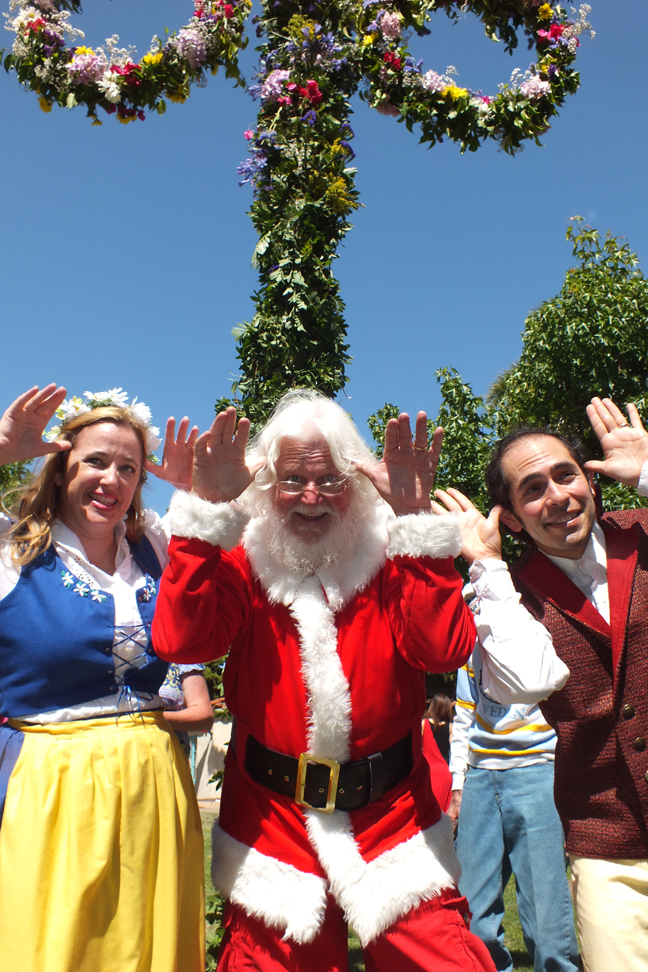 Santa joins Swedish dancers Ruth and Salomon Rojas in dancing "små grodorna" and the happy throng as they dance around the majstången (May pole) at the celebration in Balboa Park, San Diego, CA.
Santa joins Swedish dancers Ruth and Salomon Rojas in dancing "små grodorna" and the happy throng as they dance around the majstången (May pole) at the celebration in Balboa Park, San Diego, CA. -
“The food rules we are sharing with the other Santas are just a variation of what we learned as children growing up in Scandia Lodge in Pasadena,” says Sustainable Santa. “Each Saturday we attended Solstrålen (Sunbeam School) where we learned Swedish songs and dances. If we were attentive and did well in our lessons we would get Lördagsgodis (Saturday candy). That was more than enough incentive to learn "Hej Tomtegubbar" and "Nu är det Jul igen," and dance the schottis with the girls and Oxendans with the boys."
-
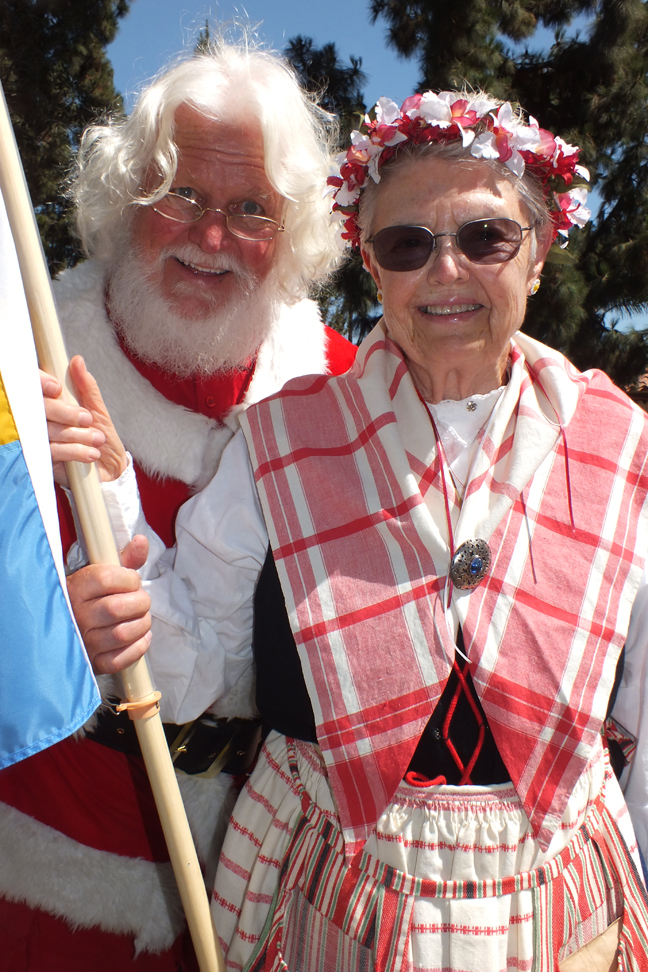 Santa and House of Sweden member Pat Coffen in her traditional Hallond dress, take a break from serving meatballs and sylt lingon to the festival celebrants. Santa thinks the Swedish National Dress is nice, but loves the outfits unique to each province best.
Santa and House of Sweden member Pat Coffen in her traditional Hallond dress, take a break from serving meatballs and sylt lingon to the festival celebrants. Santa thinks the Swedish National Dress is nice, but loves the outfits unique to each province best. -
The three “food rules,” adapted from Michael Pollan’s book of the same name, are:
-
 For children the joy of decorating the majstång is second only to decorating the Christmas tree. Santa enjoys doing that with 2-year-old Alice Lindestaf.
For children the joy of decorating the majstång is second only to decorating the Christmas tree. Santa enjoys doing that with 2-year-old Alice Lindestaf. -
Rule 1: If you are hungry, eat an apple. If you are not hungry enough to eat an apple, then you are probably not truly hungry.
-
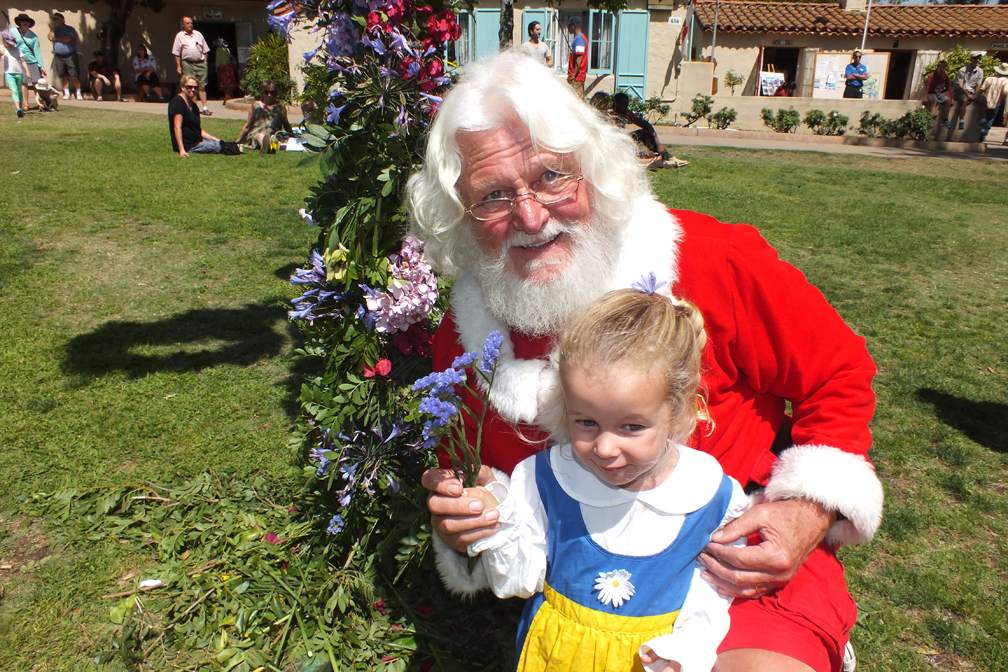 For children the joy of decorating the majstång is second only to decorating the Christmas tree. Santa enjoys doing that with 2-year-old Alice Lindestaf.
For children the joy of decorating the majstång is second only to decorating the Christmas tree. Santa enjoys doing that with 2-year-old Alice Lindestaf. -
The rationale: Americans now eat out of habit, boredom or sadness, not hunger. Kids grab a bag of potato chips or swill a Slurpee just to have something to do. If the idea of eating an apple doesn’t appeal to them, they probably are not truly hungry, and the urge will pass. But if they find the idea does appeal, then go ahead and have an apple — best an organic variety not sprayed with pesticides.
-
Rule 2: Treat treats as treats.
-
The rationale: There is nothing wrong with special occasion foods. Santa recalls his mother having cookbooks filled with recipes for fruktlimpa, strömming, lutfisk, sylta, sillsallad, vitkåls- och rödbetsallad, potatiskorv and a dozen other delicacies, all intended to delight on that special occasion called Jul (Christmas). And a cookie on Christmas Eve or a cake on your birthday is surely a very special occasion treat. But don’t make that cookie or cake, donut or cinnamon bun a daily fare — save the special treat foods, even pizza, for those truly special occasions deserving of a treat.
-
Rule 3: Follow the “S” rule: no sodas, no snacks between meals, no seconds, no added sugars, no added salt (sodium) and no sweets, except on days that begin with the letter “S.”
-
This one, clearly another product of Lördagsgodis, is one Santa knows parents love as it is easy to understand and enforce. Those familiar with the book “Why French Women Don’t Get Fat” by Mireille Guiliano, know it's a fact that in most cultures women don’t go back for seconds, nor do they eat between meals.
-
The rationale: It is a scientific fact, notes Santa, that it takes your body at least 20 minutes to feel full or satisfied after eating. But few Americans wait that long at the table. Many don’t even eat at a table — they eat in their car or in front of the television. This rule helps them break the "second helping habit," says Santa. Plus it bans the other bad things and snacking in the process — except perhaps on weekends, and even then the fact that they are thinking about it may cause them to stay away from that soda or sweet, even on Söndag (Sunday)!
-
This nyttig-mat (healthy food) promoting Santa also encourages his fellow Santas to promote patronizing farmer’s markets. He says, “They are the perfect location for introducing children to the joy of eating oprocessade råvaror (whole foods) and new taste alternatives to potato chips and sodas; we call these garden bites (hälsosnacks).”
-
And as important as it is to learn the taste of various fruits and vegetables, children and their parents also need to learn to eat their fruit, not drink it! A glass of fresh squeezed orange juice has almost as much sugar as a cola, and both far exceed the recommended daily allowance of sugar.
-
When it comes to sugar, Santa notes that when the Swedes first came to America and made that trek to Minnesota or Oregon by wagon, they packed 10 pounds of sugar per person to last them six months. Today’s American children eat between 150 -175 pounds of sugar per year. With just six teaspoons per day for an adult being the recommended daily allowance, is it any wonder the children are overweight or obese?
-
Between conducting food rule teaching sessions with other Santas and counseling the children, Sustainable Santa loves to work in Mrs. Claus’ garden. Everyday they blend a morning veggie shake with what she grows organically.
-
So why does Santa like to work in her garden so much?
“I like to hoe, hoe, hoe!” says Sustainable Santa. -
With the support of the other Real Bearded Santas he and Mrs. Claus sincerely hope this year they can make a positive impact on America’s childhood obesity issues by encouraging healthy eating. Next year they plan to take on promoting en miljövänlig livsstil (sustainable living) and the dangers of consuming genetically modified foods (GMOs). All Swedes know that GMOs are banned in Europe. But the contents of packaged foods containing them are not even labeled here in the USA.
-
The research results of the harsh side effects of eating products genetically modified to contain genes associated with pesticides are now pouring in. “At the very least,” says Santa, “American mothers should have the right to know what is in what they are feeding to their children.” Thus labeling of GMOs — if not banning then entirely — is an absolute minimum. “We hope all our fellow Vasa Lodge members will help make that happen. When that is so," says Santa, "then we all will truly have a God Jul och Gott Nytt år.”
-
By Helen Nielsen
-
About the author:
Author and columnist Helen Nielsen comes from a background of owning with her son Carlsbad Ranch Market, a produce market in Carlsbad, CA which since 1984 has offered locally grown produce. Active in the Slow Foods and nutrition movements, she has twice been nominated for a Pulitzer Prize. Her Savvy Seniors, Frugal and Active column is carried in a variety of publications. -
-
